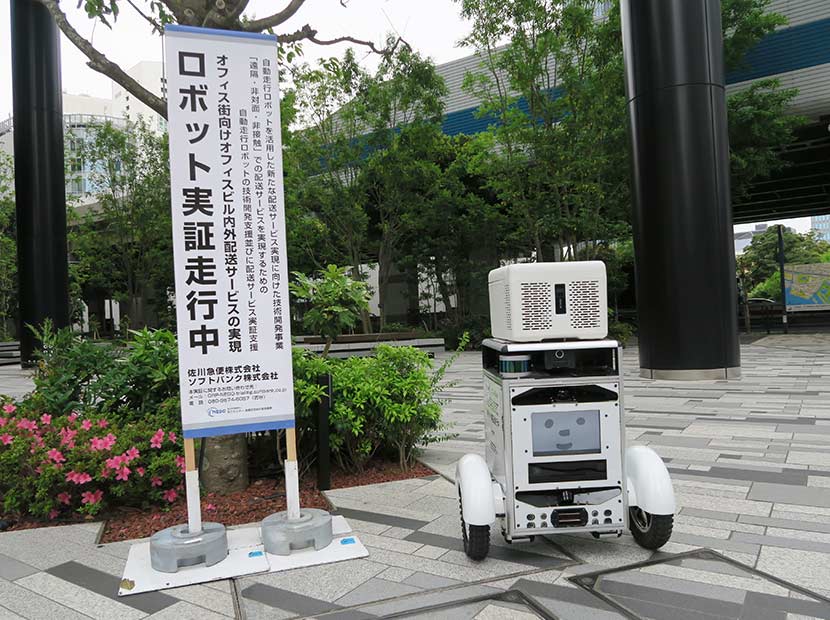
SoftBank Corp.'s (TOKYO: 9434) new headquarters is located in the Takeshiba District of Tokyo, an area designated as a National Strategic Special Zone by the Japanese government to test and deploy cutting-edge technologies. It's here in Takeshiba where various robotics initiatives are being carried out to realize the district's smart city concept.
One example are the trials being conducted by SoftBank Corp. (TOKYO: 9434) and Japan-based transportation major Sagawa Express Co.,Ltd. for delivery robots that follow traffic lights when transporting packages along public sidewalks.
Japan's first robot that follows traffic signals at pedestrian crosswalks
SoftBank and Sagawa Express conducted a demonstration in May 2021 with their self-driving robot. The robot's route was approximately 125 meters long on a public road surrounding the periphery of SoftBank headquarters. At the start of the trial, the robot left the building with a package and proceeded across a pedestrian crosswalk to reach its destination.


Navigating its way among pedestrians and vehicles, the robot kept a distance of approximately 1.5 meters from the edge of the sidewalk, avoiding planted trees and Braille blocks for visually impaired pedestrians. The robot—equipped with several LiDAR (Light Detection and Ranging) sensors and cameras that are used in self-driving applications to detect pedestrians and obstacles—repeatedly slowed down and stopped, and advanced in sync with traffic light signals at crosswalks.

The SoftBank-developed robot moved along the sidewalk at a maximum speed of 3.6 km/h. Traffic light color signals were transmitted to a BLE (Bluetooth Low Energy) roadside circuit board and an IoT router, and this information was transmitted over LTE wireless connections to the robot via the cloud.
After safely crossing the road, the robot arrived at its destination with its package intact.
Developing new technologies to realize delivery services that use self-driving robots
SoftBank and Sagawa have been conducting demonstrations with self-driving robots outdoors in the Takeshiba District from December 2020 to implement a project supported by the Japanese government's New Energy and Industrial Technology Development Organization (NEDO) aimed at developing new technologies for delivery services.
Both companies are aiming to realize contactless, non-face-to-face delivery services that use self-driving robots to address labor shortages in the logistics industry and prevent the spread of COVID-19.
Developer insight: Hurdles for delivery robots represent a business opportunity
SoftBank News spoke to Tomohiko Furutani, the person in charge of the trial, to learn more about the results and future initiatives for delivery robots.

Tomohiko Furutani
AI Robot Development Section Manager
Chief Scientist Office, SoftBank Corp.
We succeeded in conducting a self-driving robot demonstration that links with traffic light signals, but there are still areas to be addressed from a regulatory and technical perspective before we can put it to practical use.
A Japan National Police Agency report on traffic rules defined the robot used in this demonstration as a “sidewalk vehicle,” and society is becoming increasingly ready to accept self-driving robots on sidewalks. No matter how much technology advances, however, safety cannot be ensured by robots alone. Society needs to recognize the necessity of robots and accept them.
The technical challenge for future application is remote monitoring. To provide delivery by self-driven robots commercially, 1:N remote monitoring, where a single observer monitors multiple robots from a remote location, is essential, and stable communication and sufficient bandwidth are also needed to achieve this.
These hurdles represent challenges for telecommunications companies, but they also represent a business opportunity. We verified this demonstration in a 4G LTE environment, but 5G's greater bandwidth and low latency could be fully utilized for even greater effectiveness. We will continue to conduct verify trials in the surrounding area of our headquarters, which has full 5G network coverage.
(Original article posted on June 16, 2021)
by SoftBank News Editors


